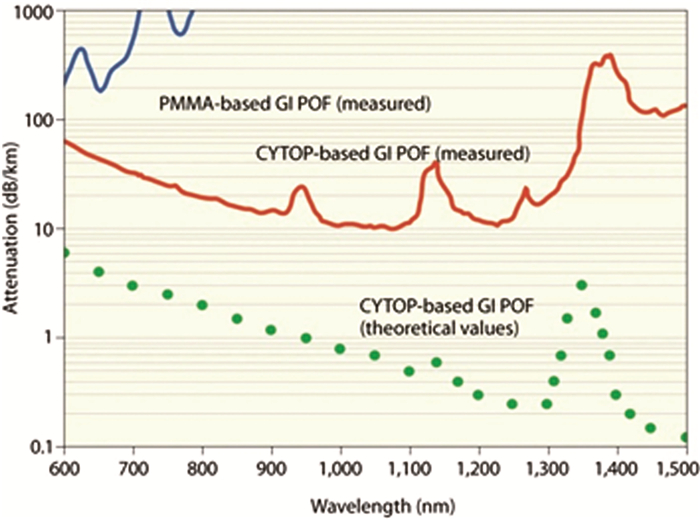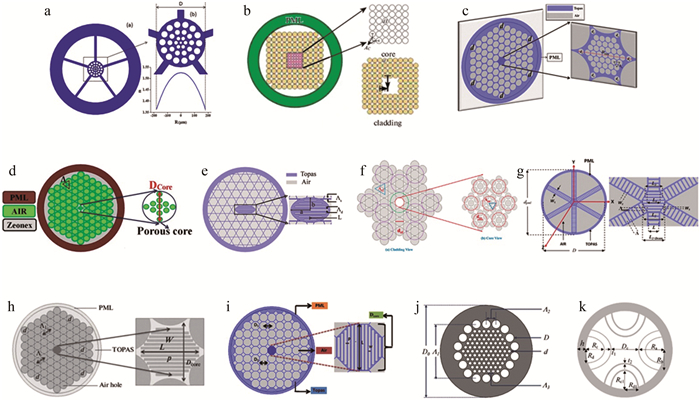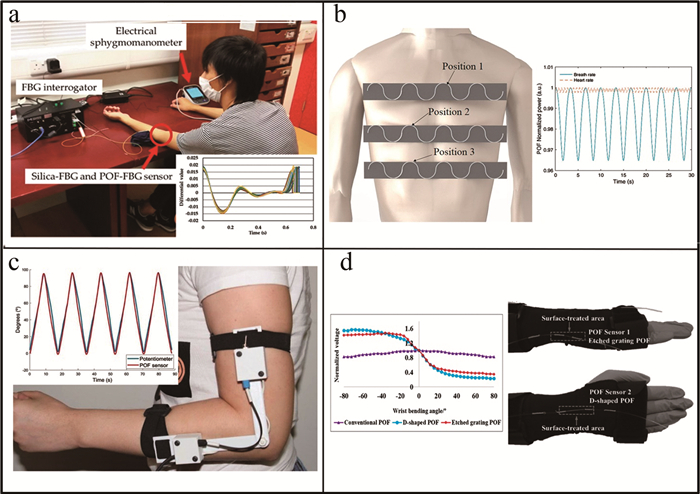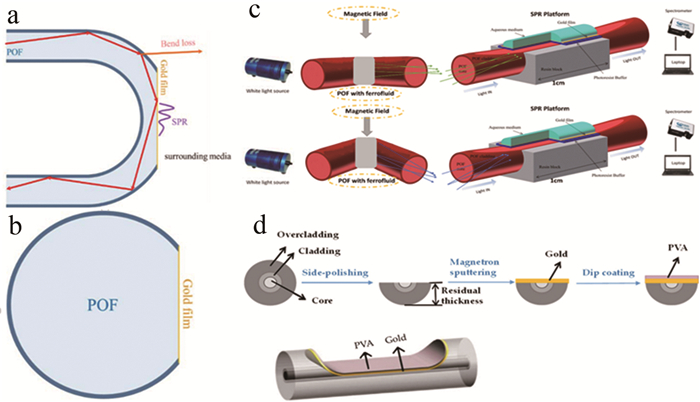HTML
-
光纤是由透明光学材料制成的光导纤维,具有传输光信号的功能。自1966年“光纤之父”高锟提出了光纤通信的基本原理和设想后,光纤通信技术便在全球范围内引发了一场革命。如今,光纤通信技术已成为通信网络中不可或缺的一部分。光纤作为传输光信号或光能量的介质,一直是科学家们研究的热点,而在光纤技术的持续发展中,聚合物光纤作为一种新型光纤逐渐成为研究的焦点。相比传统的硅光纤,聚合物光纤的优势在于其材料性质的灵活性和良好的可定制性,使其在各个领域都呈现出强大的应用潜力。目前,聚合物光纤已实现了超过50 m的50 Gbit/s的传输速率。聚合物材料的高透性和低损耗为聚合物光纤特别是微结构聚合物光纤在太赫兹频段的传输应用提供了潜力。此外,聚合物光纤在传感领域也展现出了广阔的应用前景。可定制性使其能够满足不同传感需求,并在特定应用中表现出其它光纤无法比拟的优势;同时,借助表面等离子体共振效应还可以实现高灵敏度的生物分子检测,对于生物医学和生命科学研究具有重要意义。本文作者就上述领域依次介绍了聚合物光纤的研究和应用进展,并指出未来研究的方向,以期进一步推动聚合物光纤技术的发展。
-
聚合物光纤(polymer optical fiber,POF)是由聚合物材料制成,其纤芯折射率高于包层折射率[1]。POF根据折射率分布可划分为两种类型[2]:渐变折射率型(gradient index,GI) POF和阶跃折射率型(step index,SI) POF。SI POF的纤芯与包层之间折射率阶跃变化,没有过渡层,因而存在严重的模式色散问题。而GI POF的纤芯与包层之间的折射率变化更加平滑,且纤芯折射率呈指数分布,可以大大降低模式色散[3]。
1969年,日本玻璃公司北野一郎等人首次研制出名为Selfoc的GI光纤,突破了只有阶跃折射率型SI光纤的限制,是光纤通信领域的一个重要里程碑。1982年,日本Keio大学成功研制出GI型POF,结束了只有用玻璃才能制作GI型光纤的局面[4]。通过对GI POF的进一步研究,已成功打破了POF传输带宽窄的限制,实现了100 m内3 Gbit/s的传输速率[5]。对于SI POF而言,可以通过减小数值孔径(numerical aperture,NA)来增加传输带宽,如日本Mitsubishi和Asahi Kasei公司研发出NA仅为0.25的SI POF,这种POF可用于100 m传输距离和155 Mbit/s传输速率的网络中[6]。此外,SI POF的弯曲损耗也得到了理论研究[7]。
在通信领域中,随着工艺的进步,石英光纤的传输损耗已接近理论极限。而POF凭借其抗干扰、低成本、耐辐照、重量轻、大直径、易耦合等优点得到了广泛的应用[8],更是以这些独特的优势被认为是短距离通信的最佳选择[9]。此外,POF在太赫兹技术领域中的太赫兹频段传输方面具有很大的潜力[10]。同时在传感领域POF也得到了非常广泛的应用。不仅可以应用于智能设备,还可以在健康监测、生物医学和环境检测等领域发挥作用。
-
通常,制备光纤的材料是二氧化硅玻璃,但它们在能量损耗、折射率、脆性和机械强度等方面具有一定局限性。而POF是由聚合物材料和介电材料制成,它在多个工作波长下几乎是透明的。相比于二氧化硅光纤,它还具有一些材料特性上的优势,如较低的杨氏模量,较高的弹性极限和较小的临界弯曲半径。不同的聚合物材料被用于POF的制造,可以赋予光纤不同的物理和光学特性。例如,基于聚甲基丙烯酸甲酯(polymethyl methacrylate,PMMA)的POF在可见光区域具有低损耗传输特性,而且PMMA亲水性高,可用于开发湿度传感器;基于聚碳酸酯(polycarbonate,PC)的POF具有更好的耐热性,因此可以在高温环境中使用;基于全氟树脂(perfluoro(1-butenyl vinyl ether) polymer,PBVEP)(CYTOP)的POF具有低色散特性,这使其具有更大的带宽。除此之外,聚苯乙烯(polystyrene,PS)、环烯烃聚合物(cyclic olefin polymer,COP)(ZEONEX)、环烯烃共聚物(cyclic olefin copolymer,COC)(TOPAS)也被用于POF的制造。
-
PMMA是最受欢迎和最常使用的POF材料,其玻璃化温度Tg≈105 ℃,商业型PMMA POF的工作温度范围为-55 ℃~105 ℃[11],折射率为1.49,具有良好的抗张强度和易加工特性。PMMA的传输窗口主要位于可见光的范围内,包括520 nm、570 nm和650 nm附近,这些波长可以有效地用于数据传输和通信应用。对于600 nm以上的波长,由于C—H键的振动吸收损耗,导致衰减增加[12]。如今,标准PMMA POF通常具有1 mm的直径和0.5的NA,并且在650 nm处的衰减小于130 dB/km,如图 1所示[13]。
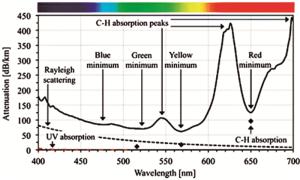
Figure 1. Typical spectral attenuation of a 1 mm PMMA SI POF[13]
-
PS是POF的第2大类芯材,具有较大的NA和良好的透光性。PS的最大优势是在670 nm~680 nm范围内显示出低衰减[14]特性。PMMA在该区域有超过200 dB/km的高衰减,而PS的衰减却低至114 dB/km[15]。标准PS POF的直径为1 mm左右,NA通常在0.10~0.15之间,衰减小于120 dB/km。
-
PC也是POF的常用材料之一,折射率为1.59。良好的机械和光学性能使其成为一种优秀的波导材料。PC的主要优势实际上在于其光学和机械性能的良好平衡组合[16]。Tg≈145 ℃,相比于其它材料,它可以在更高的温度下工作。标准PC POF的直径约为1 mm,NA在0.3~0.4之间,衰减小于100 dB/km。
-
相比上述材料,基于全氟聚合物的光纤具有更宽的光谱范围(650 nm~1300 nm),在此范围内损耗通常小于50 dB/km。但是,常规的全氟聚合物由于透明性差,无法应用于光学领域。无定形氟代聚合物透光性高,在紫外到远红外的范围内透光率达95%以上[17]。
CYTOP是由日本AGC公司研发的一种无定形全氟聚合物。由于低折射率1.34(587.6 nm),这种材料呈现出低信号色散和低光散射。对于聚合物光纤而言,氟化处理可以减少由分子振动引起的吸收损耗。因此,CYTOP POF被广泛应用于光通信和光纤传感领域[18]。CYTOP POF的NA通常在0.1~0.12之间,衰减小于100 dB/km,如图 2所示[19]。

Figure 2. Comparison of attenuation spectra between PMMA and CYTOP GI POFs[19]
-
TOPAS的Tg高于PMMA;对湿度不敏感,具有可忽略不计的吸水性,如TOPAS 8007[20]和TOPAS 5013[21];良好的生物相容性[22];恒定折射率1.53[23]。TOPAS POF的NA通常在0.35~0.38之间,衰减小于100 dB/km。
相比于TOPAS,ZEONEX光纤更容易加工制造,具有较高的透光率[24],如ZEONEX 480R[25],在高温下表现出较好机械稳定性;ZEONEX POF的NA通常在0.19~0.21之间,衰减小于120 dB/km。此外,ZEONEX与PMMA具有很好的兼容性[26]。
2.1. PMMA
2.2. PS
2.3. PC
2.4. CYTOP
2.5. TOPAS和ZEONEX
-
随着光信号处理和传输速度不断提高,金属布线已成为高速数据传输系统和大型并行处理计算机系统的瓶颈。光网络成为了代替金属布线的主要选择,尤其是用于长距离网络的二氧化硅单模光纤。但是,单模光纤的小核心连接增加了安装成本,尤其是对于预计需要大量连接的局域网。因此,研究人员提出以POF作为高速短距离网络的传输介质。POF除了具备高带宽外,还具有大芯、轻软质和低弯曲损耗等优良特性,可实现粗略的连接和易于处理,同时有望降低网络安装成本。
1970年,DuPont公司首次开发了基于PMMA的光纤(Crofon),由于高衰减,最初被用于灯饰和照明。经历了近一个世纪的发展,GI POF和SI POF均实现了低损耗传输。但相对而言,GI POF有着更大的带宽和易制造的结构[27]。例如,ISHIGURE等人[28]最先实现了一种能够在70 ℃下稳定传输的GI POF,带宽大于1 GHz·100 m;之后他们又以聚偏二氟乙烯为包层,进一步将带宽提高到了2.32 GHz·100 m,并实现了极低的弯曲损耗[29]。聚合物光纤的通信性能如表 1所示。
类型 芯材 波长/nm 损耗 带宽 传输速率/(Gbit·s-1) 特点 参考文献 SI PMMA — 160 dB/km 200 MGz·50m — 商业ESKA MH [27] GI PMMA 650 140 dB/km 1.5 GHz·100m — 高温高湿稳定性 [28] GI PMMA 650 — 2.32 GHz·100m 1~2.5 超低弯曲损耗 [29] GI CYTOP 632 — 200 MHz·km — 多模光纤干涉仪 [30] GI BPT to PMMA 650 800 dB/km 4.0 GHz·50m — 高热稳定性 [31] GI adding DBT to PS 670~680 166 dB/km~193 dB/km 4.4 GHz·50m — 高带宽;热稳定性 [32] GI PF 850 — — 120 高速传输 [33] GI halogenated polymers 850 65 dB/km 26.5 GHz·100m 10 低噪声 [34] SI PS 670 — — — 超高带宽数据通信 [35] GI PMMA 850 60 dB/km 500 MHz·km — 高质量的信号RoF传输 [36] SI PMMA 650 — 500 MHz·10m 1~5(10 m) 低误比特率(10-10) [37] GI PMMA 850 1.04 dB/m 26.5 GHz·m — 低噪声;高稳定数据传输 [38] Table 1. Performance of the POF for communication
YAMAKI等人[31]基于高热稳定性的研究成功制备了掺杂9-溴菲(9-bromophenanthrene, BPT)的PMMA GI POF,Tg>107 ℃,理论传输带宽为4.0 GHz·50 m。为实现POF在家庭网络和4K/8K视频传输方面的应用,KOIKE教授团队提出了掺杂二苯并噻吩(dibenzothiophene, DBT)的PS GI POF,带宽为4.4 GHz·50 m[32],之后他们又提出了传输速率为120 Gbit/s的全氟聚合物GI POF,其高速和低噪音性能为高清视频传输应用铺平了道路[33]。随着超高清(ultra high definition,UHD)成像技术在物联网时代的发展,INOUE等人提出了一种低噪声GI POF,成为物联网时代第1个来自光网络终端的“光毛细血管”[34]。
目前,中国在光纤领域已经取得显著进展。例如,中国科学院西安光学精密机械研究所提出了一种不同于传统SI型的中空环芯POF[35],它可以在POF通信系统中创建30个数据传输通道,用于超高带宽数据传输。相比于参考文献[35]中提出的POF的670 nm波长应用,能够支持多轨道角动量(orbital angular momentum,OAM)的玻璃光纤的应用波长可达1550 nm[39],但其商业化仍存在瓶颈。第5代(5G)移动通信系统在智能时代的背景下应运而生,然而,5G信号需要通过光纤无线电(radio over fiber,RoF)网络来支持室内环境的覆盖。因此,MURAMOTO等人[36]提出了一种具有强模式耦合的低噪声GI POF,对正交频分复用信号进行高质量的RoF传输,适用于短距离(小于100 m)家庭应用,并为5G室内宽带无线通信提供了解决方案。相较参考文献[36]中的短距离应用,MATSUURA[40]提出的用于RoF网络的双包层二氧化硅光纤在长距离(1 km)方面具有可靠的稳定性。此外,为了开发千兆级家庭网络,将光纤供电(power over fiber,PoF)与基于波分复用的多个Gbit/s数据传输集成到SI POF中[37],该方法具有为特定家庭应用和物联网生态系统的多个设备提供光供电的潜力,并满足智能物联网生态系统的需求以达到稳定可靠数据的通信。AKASHI等人[38]利用共聚工艺对光纤芯材进行模式耦合,该方法有望对UHD时代家庭光通信系统实现高度稳定和低噪声的数据传输做出贡献。LIU等人[41]制备了一种用于中红外高效成像和高容量信号传输的新型玻璃光纤,具有超高数值孔径(NA≥2.17),但其损耗(1.7 dB/m)高于参考文献[40]中的POF。
综上所述,虽然二氧化硅光纤在长距离应用上具有一定优势,SI POF和GI POF在数据通信领域的应用相对有限,但研究人员已经取得了一定进展。GI POF相比SI POF具有更高的带宽和更远的传输距离,可用于高速数据传输和仪器测量等方面。近年来,研究人员已经将重点转向微结构聚合物光纤(microstructured polymer optical fibers,MPOF),通过调节光纤的内部结构实现更低的传输损耗和更高的带宽。因此,MPOF已经成为POF领域的研究热点之一。
-
太赫兹通信频段(0.1 THz~10 THz)可以支持从几个GHz到超过1 THz的广泛频率范围的数据传输。然而,在长波长范围的光纤通信中,聚合物的传输损耗相比石英光纤要高得多[42-43]。太赫兹光纤主要着重于传输0.1 THz~10 THz频率范围内的电磁波,这些波在聚合物材料中的传播损耗较石英光纤低[44-45],对太赫兹波的传输具有积极影响。因此,大部分用于太赫兹波传输的光纤都选择使用聚合物材料制作。
在此背景下,EIJKELENBROG等人首次提出以PMMA为基材的MPOF[46],光纤包层中按照特定规则周期性排列着大小在波长数量级的空气小孔。这种光纤具有许多独特的性能,例如可以控制光的传播方向,实现在不同波长范围内光的分离。同时还具有很强的非线性光学效应,使其在多个领域有着广泛的应用[47]。此外,MPOF还具有一些独特的特征,如通过改变孔结构来调整折射率分布的能力、制造高双折射或高数值孔径光纤的能力以及通过光子带隙引导在低折射率材料中引导光的能力等。这些特性使得MPOF在太赫兹波传输方面具有广阔的应用前景。随着太赫兹波导器件的发展,如何降低传输损耗和色散,成为了太赫兹光纤研究的关键问题之一。研究表明,太赫兹波可以在干燥的空气中几乎无损耗地传输。因此,增加太赫兹波在干燥空气中的传输比例可以显著降低传输损耗[48]。MA等人制作出了一种GI型多孔光纤,其损耗显示出0.025 cm-1~0.15 cm-1的变化,该设计不仅实现光纤的低损耗传输,还拥有平坦色散[49]。ISLAM等人提出了一种kagome晶格包层的MPOF,实现了0.05 cm-1的损耗[50]。
在过去的几年中,人们对空心MPOF进行了很多研究。空心结构可以大大减少有效材料损耗(effective material loss,EML),降低色散。为了实现尽可能低的损耗、更高的内核功率分数、更高的有效面积和超平坦色散,同时更容易制造的太赫兹光纤,需要设计出更加优良的结构。MEI等人[51]提出了一种GI型MPOF,该结构将太赫兹波与外界环境隔离,在光纤受到切割和外部环境干扰的应力时更加稳定和不易变形,同时实现了(0.14±0.07) ps/(THz·cm)的低平坦色散。在以前的研究中[52-55],会在纤芯中引入气孔环使芯体和包层之间的有效折射率差值增加,从而将光很好地限制在核心中以减少损耗。为了保证光纤的灵活性,仅使用一圈气孔以增强光纤的柔韧性,但表现出的损耗和色散相对较高[56]。HABIB等人[57]设计一种低损耗太赫兹传输的新型方晶格多孔芯MPOF,此结构简单且易于实现,具有47%的功率分数。YAKASAI等人[58]基于传统六方晶格包层实现了低成本太赫兹多孔光纤,损耗约0.039 cm-1。UPADHYAY等人[59]基于ZEONEX提出了六角多孔包层和菱形多孔芯光纤,实现了0.014 cm-1的低损耗和(0.469±0.246) ps/(THz·cm) 的平坦色散。
高双折射太赫兹光纤是由CHEN等人首次引入的[60],并设计出了0.1057的高双折射太赫兹光纤。然而却在机械稳定性和相对较高的色散方面受到质疑[61]。因此,一种具有更高的双折射、低损耗和低色散的机械稳定性的设计前景很吸引人。ISLAM等人提出一种kagome晶格包层的高双折射椭圆形MPOF[62],损耗为0.056 cm-1,可以在300 GHz的带宽上实现非常平坦的色散,且具有不错的机械稳定性。AHMED等人[63]提出了基于TOPAS的圆型星形MPOF,纤芯和包层区域均由圆形空气腔形成,光纤损耗0.016 cm-1,有效面积1.38×106 μm2,在1.0 THz~ 2.3 THz范围内具有平坦色散。和过去的开槽芯光纤相比,SINGER等人[64]设计的MPOF是首次同时具有高双折射、低EML、低约束损耗和超平坦几乎零色散的悬槽芯光纤。AMINUL等人[65]实现了一种双折射为0.09的太赫兹开槽芯光纤,该光纤具有0.025 cm-1的超低损耗。之后,ISLAM等人设计了一种带有方形气孔和八角形包层的新型开槽芯光纤,通过这种新颖的设计,实现了0.007 cm-1的极低损耗和(0.3±0.1)ps/(THz·cm)的近零平坦化色散[66]。由于该光纤优异的性质,使得其在制造光学设备、医疗诊断设备、低损耗偏振应用和有效太赫兹波传输方面成为最佳候选者。除了上述提及的开槽芯MPOF外,还有最低色散变化约为±0.004 ps/(THz·cm)的MPOF[67]和伞形包层开槽芯光纤[68]。
然而,人们对上述的开槽芯MPOF能否成功生产有较高的担忧。因为在光纤制造过程中,开槽的气孔难以维持其形状和尺寸。因此,仍有机会设计低损耗的太赫兹波传输光纤。HOSSAIN等人针对太赫兹通信领域提出了包层区中5层十边形和芯区中2层椭圆形的结构设计,其损耗低至0.0079 cm-1,遗憾的是,他们并没有对光纤的色散特性进行研究[69]。MEI等人提出了一种多孔结构的太赫兹MPOF,该光纤具有0.018 cm-1~0.0345 cm-1的低传输损耗和(-0.285±0.02)ps/(THz·cm)的平坦接近零色散带[70]。最近,XUE等人[71]设计了一种基于ZEONEX的太赫兹光纤,采用4管嵌套的半椭圆包层管结构,可以提供更好的传输特性和更高的设计自由度,且该光纤有可能具有目前实现的最高极化损耗比(polarization loss ratio,PLR)。一种中空芯光纤可以用于实现高灵敏度气体传感器,表现出0.0013896 dB/m的低EML和99.9538%的最大灵敏度[72]。MPOF的具体结构如图 3所示,其对应的性能参数如表 2所示。
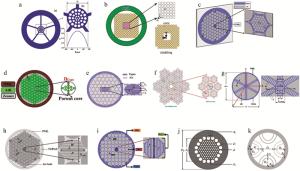
Figure 3. a—wheel-like structure suspended gradient refractive index porous core fiber[51] b—square lattice porous core microstructured fiber[57] c—conventional hexagonal lattice cladding porous core microstructured fiber[58] d—hexagonal porous cladding rhombic porous core microstructured fiber[59] e—elliptical seven-level horizontally slotted porous core microstructured fiber[62] f—circular-based star microstructured fiber[63] g—rectangular porous overhanging slot core microstructured fiber[64] h—hexagonal circular porous cladding variable length rectangular slot overhanging slot core microstructured fiber[65] i—octagonal tetragonal cladding slotted core microstructured fiber[66] j—porous core microstructured fiber with hexagonal circular aperture cladding[70] k—microstructured fiber with 4-tube nested semi-elliptical cladding tubes[71]
x光纤 材料型号 芯孔x直径/m 带宽/THz 损耗/cm-1 色散/(ps·THz-1·cm-1) 特点 参考文献 图 3a TOPAS 432 0.71~0.95 0.06 0.14±0.07(0.8 THz~1 THz) 超平坦近零色散,GI悬浮多孔芯 [51] 图 3b ZEONEX 390 0.7~1.15 0.06 0.85±0.12 低EML;宽带低色散变化;功率分数(47%) [57] 图 3c TOPAS 300 0.4~1.7 0.04 0.47±0.05 平坦近零色散 [58] 图 3d ZEONEX 54.1 0.7~1.5 0.0145(0.7 THz) 0.469±0.246(0.8 THz~1.3 THz) 高功率分数(75%);极低弯曲损耗(3.1×10-20 cm-1) [59] 图 3e TOPAS — 0.85~1.7 0.056 <0.5 双折射(9.73×10-2);机械稳定 [62] 图 3f TOPAS 355 0.5~2.5 0.016 — 超低损耗;大有效面积(1.38×106 μm2) [63] 图 3g TOPAS 400 0.8~1.2 0.016(TE), 0.028(TM) 0.54±0.08(TE), 0.94±0.1(TM) 高双折射(0.09);低损耗;平坦色散 [64] 图 3h TOPAS 270 0.5~1.6 0.025 0.65±0.05 低EML,高双折射(0.0911) [65] 图 3i TOPAS 290 0.4~2.1 0.007(0.5 THz) 0.3±0.1 超低损耗;大模有效面积(4×10-6 m2) [66] 图 3j ZEONEX — 0.2~1 0.0180~0.0345(0.3 THz~0.5 THz) -0.285±0.02(0.39 THz~0.45 THz) 低EML;平坦近零色散 [70] 图 3k ZEONEX — 0.42~0.60 0.98dB/m(0.5 THz) — 小尺寸;最高PLR [71] Table 2. Performance of the MPOF for communication
目前,针对太赫兹波传输的MPOF结构设计尚未达到最佳性能,但具有周期性光子晶体结构的MPOF在太赫兹波传输方面具有潜在的应用前景。为实现更好的性能要求,研究人员需要继续探索MPOF的结构设计。另外,太赫兹光纤在双折射、色散和损耗等方面仍有改进空间。但是,高双折射、平坦色散、低损耗、高功率约束和基于低约束损耗的太赫兹光纤之间的平衡具有挑战性。光纤的制备过程也是如此,包括钻孔、溶胶凝胶、铸造、堆积、挤出和3-D打印等方法。因此,选择光纤制备方法时不仅要考虑适用性,还需考虑光纤材料成本。相比之下,聚合物光纤制造成本低、制备工艺简单、重量轻、柔韧性好,在太赫兹波传输方面更具优势。
3.1. 聚合物光纤通信
3.2. 太赫兹光纤通信
-
光纤传感技术因其准确、灵敏的特点被应用于可穿戴传感设备中,用于监测人体的生理信号[73-74]。基于POF的传感器相比于传统光纤传感器具有诸多优点:抗干扰性能更好,可以减少电磁干扰对传感器信号的影响;材料柔韧性强,能够适应复杂的形状和运动,因此,更适合于可穿戴设备和人体感知;POF传感器具备大断裂应变能力,能够承受较大的机械变形而不影响其性能;最重要的是,POF材料对生物体相容性较好,对人体无害,适用于医疗领域[75]。
脉搏信号的监测对人体健康的预警很重要。QUANDT等人在纺织物上设计了一个基于ZEONEX的多模SI POF脉搏监测传感器[76],既能确保小的弯曲半径和强光耦合输出,又保证了在长时间使用或经过多次摩擦后的舒适性,这种特性对截瘫病人来说可以减少发生压疮的风险。HASEDA等人[77]使用基于PMMA的多模SI POF来测量人体的脉搏波信号,如图 4a所示,该传感器测得的脉搏波信号的信噪比约为二氧化硅传感器的8倍,体现了POF在这类应用中的潜力。LIANG等人[78]提出了一种基于自混合干扰与嵌入聚二甲基硅氧烷(polydimethylsiloxane,PDMS)的光纤集成传感器,通过光纤反射光的功率变化连续实时准确地监测脉搏波,并通过脉冲传输时间成功监测人体血压。一种由PDMS封装的双通道光纤传感器首次被提出[79],用于同时监测肱动脉和桡动脉,以准确预测血压。虽然在相关系数上双通道传感器要高于提及的其它传感器,但考虑到测试范围的影响,稳定的准确性则是更需要关注的。
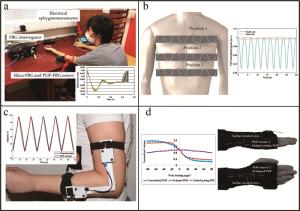
Figure 4. a—configuration of the pulse monitoring sensor and monitoring results[77] b—sensor localization on the chest and heart rate simulation results[82] c—sensor position on the elbow joint and joint angle measurements[92] d—position of the POF sensor on the elbow joint and response curves to bending angles[93]
心率和呼吸频率是人体生理健康的基本参数,有效的监测[80-81]可以帮助避免危及生命的情况。LEAL-JUNIOR等人[82]开发了基于PMMA POF的智能纺织品,可同时测量呼吸和心率,如图 4b所示。值得一提的是,一种使用智能手机集成的呼吸监测传感器被提出[83],相比于参考文献[84]和参考文献[85],可以允许任何4G或Wi-Fi连接设备进行远程数据访问。HAN等人[86]研究了嵌入床垫中的PMMA POF传感器,用于测量呼吸和心率以及睡眠状况,该传感床垫不但可以区分与不同睡眠情况有关的不同行为状态,还可以检测不同姿势下的呼吸和心率值。XU等人[87]首次将石英光纤中的长模干扰应用于体征监测,且传感效果与传统的医学监测设备非常吻合,具备同参考文献[86]一样的家庭使用潜力。
身体关节角度的测量对于康复活动中的实时监测是相当重要和有用的。光纤传感器已从监测单个关节角度[88]发展到监测多个关节角度[89],传感器的封装或制造材料已从硅玻璃[90]转变为更加柔韧的材料[91]。REZENDE等人[92]实现了一种新的便携式角度传感系统,如图 4c所示,该系统是基于PMMA的多模POF进行设计的,用于肘部关节角度的测量,其表现出的高可重复性和高行为相似性具有人体工程学的优点。LI等人[93]开发了一对新型可穿戴和灵敏度增强的POF应变传感器,如图 4d所示,该传感器的低角度误差(2.94°),体现了其在人体关节康复方面的潜力。除此之外,还有伤口智能绷带[94]、伤口pH值评估[95]、检测肌肉激活状态[96]的光纤传感器研究。
-
相比于传统的光纤传感器,微结构光纤传感器具有高感测范围、可控性强以及可实现在线监测等优势。而且,在聚合物中使用微结构的优势甚至比在玻璃光纤中更加深远,它们能够轻松生产在可见光下运行、低损耗的单模光纤,这对于传感技术很重要。因此,MPOF为液体检测提供了全新的可能性,液体被填充到孔中,由于表面积增加而具有更强的相互作用。此外,MPOF因其制造简易性和多功能性,相比于它们的玻璃同类产品具有更多优势。
在液体检测方面,IQBAL等人[97]提出了一种六边形MPOF传感器来检测和分类不同类型的酒精,该模型在光学参数方面提供了足够的灵活性,且显示出较高的液体传感性能。之后,HOSSAIN等人[98]针对醇的检测提出了一种MPOF传感器,该传感器在1 THz时对乙醇、丁醇、丙醇具有86.60%、88.70%和84.71%的高灵敏度,非常适用于醇类的检测。乳脂含量是牛奶质量评估的重要参数。GOWRI等人利用U型POF探头开发手持式高灵敏度光纤乳脂传感器[99],该结构设计便于进行浸渍式传感,还可以提供对牛奶质量的实时和非破坏性分析。ZHAO等人采用逐渐热压扁平结构的POF传感器来测量葡萄糖溶液的折射率(refractive index,RI),在1.33~1.38的RI范围内实现了最大的传感灵敏度[100]。此外,LIU等人[101]设计的双探头气液两相光纤传感器,可用于室温下监测气相和液相中的丙酮并不受湿度影响,较部分POF传感器更具工业意义。BAO等人[102]提出的中空芯光纤的液位传感器对离散液位测量,特别是对于一些易燃易爆液体具有潜在意义。
在万物互联的今天,单方面的光纤传感器研究已趋于成熟,而与其他智能设备相结合的设计方式正在兴起。YE等人[103]采用在POF上钻微孔的低成本方法,制造与智能手机集成的POF液位和RI传感器。该设计在实时液位和RI监测方面具有很大竞争力。现有的一些液体传感研究,其具体参数如表 3所示。
分析物 频率/THz 有效材料损耗/cm-1 约束损耗 双折射率 有效面积/μm2 相对灵敏度/% 参考文献 水 2.4 0.0061 1.64×10-13 cm-1 — — 97.60 [104] 甲醇 2.0 0.00085 2×10-16 dB/cm 0.00015 1.85×108 99.36 [105] 乙醇 1.7 0.0057 3.85×10-13 cm-1 — 3.12×105 93.80 [106] 苯 1.4 0.0027 8.63×10-16 cm-1 0.007 1.49×105 98.92 [107] HCN 2.0 0.023 1.62×10-9 cm-1 0.009 — 85.80 [108] 血红蛋白 1.5 — 1.135×10-14 cm-1 — 1.66×105 80.56 [109] 福尔马林 1.8 0.0048 2.798×10-11 cm-1 — 9.77×105 77.71 [110] 苯丙胺 1.0 0.02 6.2×10-8dB/m — 1.39×105 89.50 [111] 煤油 1.0 0.0025 2.16×10-8 cm-1 — — 97.6 [112] 神经毒剂 1.8 0.00859 1.71×10-14 cm-1 0.00682 — 94.40 [113] 汽油 2.8 0.0072 8.10×10-9 cm-1 — — 96.87 [114] Table 3. Performance comparison of different liquid sensors
-
传统温度传感器基于电阻、热敏电阻和热电偶等原理进行测量,但存在响应速度慢和测量范围狭窄等问题。为了满足更高性能要求,人们开始关注POF温度传感技术[115]。
TIAN等人[116]基于气球状的弯曲单模光纤开发了一种高灵敏度的温度传感器,虽然传感器的温度灵敏度较高,但其只作用在20.7 ℃~31.7 ℃的温度范围内。GUO等人[117]通过在可拉伸聚合物基光纤(stretchable polymer-based fiber,SPOF)中掺入热敏上转换纳米颗粒(upconversion nanoparticle,UCNP)制造了一种可穿戴温度传感器(UCNP-SPOF),用于人体体温监测。UCNP-SPOF传感器不仅具有出色的拉伸性,还能够以高线性度和灵敏度准确检测25 ℃~70 ℃范围内的温度变化,低检测(limit of detection, LOD)为±0.3 ℃。大脑温度是一个重要的生理参数,大芯柔性低损耗的CYTOP POF脑温度探头,有可能作为可靠的高分辨率脑植入物进行温度传感[118]。此外,基于光纤的应力-光学效应原理提出的SI POF温度传感器能够在110 ℃下稳定工作[119]。相比于低温传感,SU等人[120]设计的石英光纤高温微型传感器不仅能够稳定地承受800 ℃的高温,且适合大规模生产。KHAN121]提出了一种基于快速、低成本、高灵敏度、宽动态范围和便携式SPOF脉宽调制的温度传感器,此系统能够在21 ℃~70 ℃的范围内实现线性传感性能和出色的稳定响应质量。至此,本文作者总结了现有的一些温度传感研究,如表 4所示。
结构 长度/mm 温度/℃ 灵敏度/(nm·℃-1) 参考文献 PMMA POF — 15~45 0.1275 [115] UCNP-SPOF 25 25~70 — [117] CYTOP POF 10 30~40 0.0143 [118] PMMA-POF — 25~100 1.04 [119] PEDOT:PSS-SPOF 20 21~70 — [121] PDMS-assisted BFS 27 21~25 -1.63 [122] SMF-FPI 100 36.0~36.4 83.13 [123] the SMF end-face coated with PDMS — -30~85 0.698 [124] ZnO@Gr/MMF-TSCF-MMF 10 89~98 0.33268 [125] dual-core toluene and ethanol filled PCF — 0~70 -11.64 [126] -80~0 -7.41 SCF-EU-LPFG 5.5 30~100 0.53 [127] MMF-TDF-MMF 7 100~650 0.088 [128] 650~850 0.150 900~1000 0.285 Table 4. Performance parameters of fiber optic sensors for different temperatures
综合以上情况,由于制备材料的限制,石英光纤温度传感器比POF温度传感器具有高温稳定性和更广泛的工作温度范围,且二氧化硅光纤传感器的制备工艺相对成熟,因此被广泛应用[129-132]。但在便携性、低成本、低温范围方面,POF更具实际价值。
-
随着现代医学和生物科学的不断发展, 生物相容性和生物可降解性光纤得到了人们的重视。这种光纤可以长时间与人体接触而不会引起排斥反应, 具有良好的生物特性。可以在医疗、环保和生物研究等领域中发挥着独特的功能, 例如,可以将光从光源直接传递到目标组织,达到精准的治疗效果;可以用于生物成像,帮助医生观察和诊断疾病;还可以在环境保护中发挥出它的优越性能,它可以分解成更小的分子,减少对环境的污染。
2007年,出现了第1种由纤维素制成的约1 dB/cm传输损耗的可生物降解聚合物光纤[133]。之后,SHADMAN等人提出了基于生物相容性材料的微结构光纤[134]。迄今为止,人们在开发生物相容性和可降解的MOF方面只进行了非常有限的努力,获得的光纤具有高衰减性。因此,GIEREJ等人[135]使用外消旋聚乳酸(poly-D, L-lactic acid, PDLLA)制造了可生物降解和生物相容的微结构聚合物光纤。基于PDLLA的MPOF具有出色的光学特性和实现可控降解速率的潜力。此外,生物基光纤传感器应用还有:基于蜘蛛丝的光纤磁场传感[136];基于再生纤维素和醋酸纤维素的光纤水传感器[137];琼脂糖基结构的光纤[138];基于水凝胶光纤的高拉伸应变传感[139];基于包芯磷酸盐玻璃光纤的生物传感[140];用于间质光动力治疗的生物相容性POF[141]等。
未来,生物相容性和降解性光纤的发展方向将主要集中在以下几个方面:(a)材料研究。新型生物相容性和降解性光纤材料的研究将是未来的发展方向之一,以提高光纤的稳定性和使用寿命;(b)技术创新。光纤技术创新将进一步扩大其应用范围,如利用生物相容性和降解性光纤开展新的医疗治疗方案;(c)应用领域拓展。生物相容性和降解性光纤在生物研究、环境保护等领域的应用将不断拓展,为人类的健康和环保事业做出更大的贡献。
-
表面等离子体共振(surface plasmon resonance, SPR)传感器是近年来迅速发展的研究领域之一。它利用激光与金属表面等离子体的相互作用来检测样品中的生物分子信息,如图 5所示。光纤SPR传感器是在1993年被首次提出的[142],因损耗低、小型化、耐腐蚀和易分布监测等优势,在各种传感器件中引起了广泛关注并取得令人满意的效果[143]。相比于二氧化硅光纤传感设备,POF在提高传感器灵敏度方面具有独特优势。此外,结合POF的可塑性、易于集成和模式可控等优点,使得POF SPR传感器具有广泛的应用前景。
-
JING等人提出一种基于热定型和侧面抛光技术的POF-SPR传感器,如图 6a和图 6b所示,该传感器采用SPR和弯曲损耗结合机制来确定RI[144]。2021年,CENNAMO等人[145]提出一种基于D形POF和磁流体的SPR传感器,如图 6c所示,利用SPR光谱的变化以达到检测磁场的目的。一种基于空心光纤的SPR磁场传感器[146],首次将金纳米颗粒和磁流体与SPR传感器结合,但在传感灵敏度方面劣于参考文献[145]。WANG等人[147]提出一种用于高度敏感的相对湿度(relative humidity,RH)和人体呼吸监测的SPR传感器, 如图 6d所示,该传感器在70%~90%的RH之间表现出线性响应,具有较高灵敏度;此外,用于人体呼吸测试时,显示出高达228.2 nm的平均波长偏移,是基于二氧化硅光纤湿度传感器的10倍。2022年,TENG等人制备了一种基于U型锥形POF的SPR传感器[148],该传感探头结构简单易制造。XUE等人提出基于采用机械热压法制造的扁平化POF的SPR传感器[149],该传感器展现出2507 nm/RIU的超高灵敏度,适用于生化、医疗领域。此外,ARCADIO等人[150]通过在D形SPR传感器的输入端连接一小块POF贴片,设计了一个力传感器,当施加在贴片上的力发生变化时,多模POF贴片和SPR POF传感器中光的模式分布也会随之改变,从而导致SPR光谱发生偏移,最终,该传感器具有约22 mN的分辨率值和在0 N~0.5 N范围内的优异线性响应。LU等人[151]利用SPR光纤水压传感器,证明了在中心气孔内加入薄介质层,可以大大提高传感性能,为新型传感器结构提供了思路。
-
自COVID-19爆发以来,全球大力推动开发创新检测技术,将其作为成功预防和控制流行病的关键因素[152]。在生物检测[153]、医疗诊断[154]和人体健康监测[155]等多个领域,光纤传感器已被证明具有广泛的优势,并表现出极高的检测灵敏度。CENNAMO等人[156]设计了一种特定的分子印迹聚合物(molecularly imprinted polymer,MIP)受体,如图 7a所示,用于快速、高灵敏度和实时性的检测水溶液中的SARS-CoV-2病毒。后来,该小组又开发了一种用于检测SARS-CoV-2刺突糖蛋白的受体结合结构的高灵敏型光学传感器,如图 7b所示[157],根据不同干扰物的测试结果,确认传感器具有良好的特异性;在稀释的人血清测试中,LOD约为75.26 nm。
此外,CENNAMO团队还开发并测试了两个SARS-CoV-2传感器,传感器的灵敏度被证明足以检测病毒体[158]。近几十年来,科学家们对太赫兹辐射带给予了大量关注。太赫兹辐射波段可以通过光纤传输,不会对人类健康构成威胁[159]。因此,有人提出了基于太赫兹波的光纤传感器,并首次用于脑癌的检测,结果表明,该传感器能够精确区分11种不同类型的脑损伤、肿瘤和癌细胞[160]。目前,番茄叶卷曲新德里病毒DNA的检测已通过U型弯曲光纤传感器呈现[161],血浆浓度检测可以通过中空芯光纤传感器实现[162]。未来,会有更多的传感平台用于生物医疗检测,并且便携式小型化版本的传感器还具备带来社会经济效益的潜力。
-
近年来,由于大量化合物在环境中存在,并且表现出潜在的毒性,社会和科学界便针对这些化合物展开了研究[163]。CENNAMO等人[164]利用高灵敏的POF SPR传感器来检测环境中全氟化合物的含量,如图 8a所示。使用间接酶联免疫吸附检测法(enzyme-linked immunosorbent assay,ELISA)确定抗体滴度,测定的LOD为0.21×10-9,低于欧盟规定的最大残留限量(0.5×10-9),更优于0.4×10-9的石英光纤传感器[165]。之后,CENNAMO小组又开发了一种SPR传感器来检测海水中萘的浓度[166],用产生的抗体对POF镀金表面进行功能化,通过ELISA测试与萘结合的能力,其LOD低于水环境质量标准中萘的最大残留限值,为0.76 ng/mL。图 8b显示了用特异性抗体功能化的SPR-POF平台对不同萘浓度的传输光谱。TENG等人提出一种基于双面抛光的U型POF SPR传感器,可同时测量RI和温度[167]。但该传感器的灵敏度低于带温度补偿的高灵敏度双通道光纤SPR传感器[168]。HIRAI等人[169]开发出一种具有高灵敏度和10%~90% RH检测范围的湿度传感器,他们首先研究了使用羟乙基纤维素作为POF包层材料的湿度传感器,但灵敏度很低;之后他们通过在包层中掺杂0.8%亮蓝来提高灵敏度;然而,这使得传感器的检测范围太窄,无法实际使用,因此,他们利用传感器的输出波形取决于入射光线的波长的事实,将入射光线从单一波长改为两个波长,从而创造了一个具有高灵敏度和宽检测范围的传感器。
为了在检测重金属离子的同时监测周围折射率的变化,ZHANG等人[170]提出了一种在实时检测方面具有与POF SPR传感器相同效果的二氧化硅光纤SPR双通道光纤传感器。针对弱腐蚀环境和早期腐蚀监测的应用场景,开发了一种基于SPR效应的高灵敏度光纤腐蚀传感器[171],适用于弱腐蚀环境下金属早期腐蚀条件的实时连续监测。
-
CAO等人[172]提出一种基于低指数POF的高灵敏度SPR生物传感器,使用D型侧面抛光的几何形状用来激发SPR,用于葡萄糖传感时,在未固定葡萄糖氧化酶的情况下,表现出较高的灵敏度。一般情况下,大肠杆菌菌株是无害的,但其中一部分具有致病性。对此,ARCAS等人[173]提出一种用于检测大肠杆菌的U型SPR传感器,其传感原理及实验流程如图 9a所示,该传感器具有1.5×103 CFU/mL的细菌浓度LOD,使其成为传统检测方法的低成本、便携式替代方案。铜(Ⅱ)是人类健康的必需元素,但是,当以高浓度存在时,它可能会对人类健康产生影响。PESAVENTO等人[174]开发了一种用于选择性检测饮用水中铜(Ⅱ)的POF SPR传感器,如图 9b所示,该传感器能够检测到4×10-6 mol/L~2×10-4 mol/L浓度范围内的铜(Ⅱ)。之后,他们结合仿生受体MIP检测发酵饮料(如葡萄酒)中的糠醛(2-furaldehyde, 2-FAL)浓度[175],测试并比较了具有不同MIP层数的传感器的传感性能和糠醛在水、葡萄酒模拟溶液和白葡萄酒样品液中的传感效果,实验证明,葡萄酒中的亲和性常数比在水中高一个数量级,在测定葡萄酒中的2-FAL时,得到了0.004 mg/L的低检测限。值得一提的是,该传感器也可以很容易地适用于其他呋喃类化合物的分析。
迄今为止,大多数报道的POF SPR传感器都是基于商用PMMA的多模POF,这是因为商用PMMA的制备工艺成熟、成本较低,且具有良好的光学质量和稳定性。此外,商用PMMA也易于加工和切割,在制备POF SPR传感器时非常方便。不过,随着技术的进步和应用需求的不断提高,未来可能出现更多的材料可供选择,以满足不同的应用需求。综上所述,无论是POF传感器还是基于POF的SPR传感器,在物理研究、生物医疗、健康监测和环境监测等方面,都有其各自的优缺点。因此,在选择传感器时应结合应用需求进行评估和选择。
4.1. POF/MPOF传感
4.1.1. 健康监测
4.1.2. 液体检测
4.1.3. 温度检测
4.1.4. 生物特性
4.2. POF SPR传感
4.2.1. 物理研究
4.2.2. 生物医疗
4.2.3. 环境监测
4.2.4. 食品安全
-
随着研究的深入和科技的进步,POF已经成为一种性能优越、具有广泛应用前景的光学通信介质。同时,POF传感器也已成为一种备受关注的研究热点和具有广阔应用前景的光电器件。本文作者主要介绍了POF在光通信领域的发展现状,分别讨论了POF传感器在物理研究、生物医疗、健康监测和环境检测等领域等方面的实际应用。
(a) 在聚合物光纤通信方面,未来的发展重点将是提高其带宽、稳定性和可扩展性,以满足数据传输需要的高速化、低功耗和低成本需求。同时,聚合物光纤通信技术还有望在无线通信、军事系统、医疗等领域得到进一步拓展。然而,POF的制备需要高技术含量,且成本较高,因此研究者还需要致力于降低成本并加强其稳定性和环保性,以满足实际应用的需求。
(b) 在聚合物光纤传感器方面,未来的发展方向是高灵敏度、高分辨率和高可靠性,扩大应用范围,例如在生态领域、能源领域和智能制造等领域的应用,同时寻求新的应用领域和解决实际应用中的瓶颈问题。传感器还有望与人工智能、大数据等技术结合,实现实时监测和数据分析,使人们的生产和生活更加便捷。但是,POF传感器在工业应用方面存在实验室与工业生产之间的差距,还需要进一步优化制备工艺,降低成本,加快成果转化。
总之,聚合物光纤通信和传感技术的不断发展和完善,将有助于推动光电技术的发展和应用。随着科技的不断进步和人们需求的增长,聚合物光纤通信和传感技术将会迎来更加广阔的发展前景,也将为人类探索未知领域提供强有力的支持。

 Map
Map


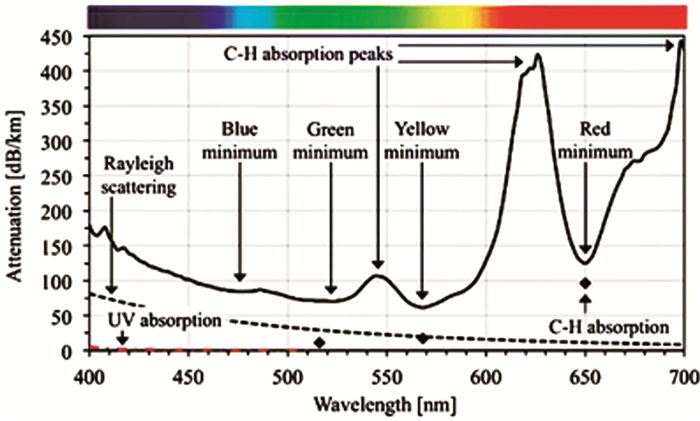


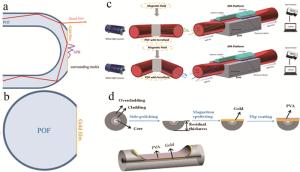



 DownLoad:
DownLoad:
